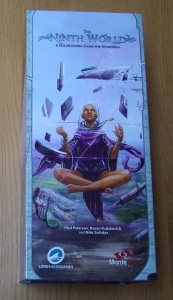 The 9th World: A Skill-Building Game for Numenera – set 1 Billion years in the future.
The 9th World: A Skill-Building Game for Numenera – set 1 Billion years in the future.
I backed this game at the very end of 2015, although the campaign only closed/card got charged in January of 2016, with delivery expected that October.
The History
I’ve said it before, but I’ll repeat again, for anyone who hasn’t read the entire blog (i.e. everybody who isn’t me!)
 9th World came from the makers of the Apocrypha ACG, and the campaign was announced to Apocrypha backers with a definite tone of “as we’re basically done with Apocrypha, here’s our next project.” At the time, we had no notion of the nightmares to come with Apocrypha, so I doubt I was alone in thinking “these guys seem like a nice bunch, let’s have a look at their other game.”
9th World came from the makers of the Apocrypha ACG, and the campaign was announced to Apocrypha backers with a definite tone of “as we’re basically done with Apocrypha, here’s our next project.” At the time, we had no notion of the nightmares to come with Apocrypha, so I doubt I was alone in thinking “these guys seem like a nice bunch, let’s have a look at their other game.”
The rest, as they say is tragedy… history. Delays, followed by other delays. Claims that things were nearly ready, which with hindsight were clearly nonsensical.
Apocrypha finally arrived in October 2018 – (base game only, there was a further 13 months to wait for the expansions). It was a real let-down: a worse version of a game we’d already moved on from, with a virtually indecipherable rulebook, and mechanics that tried too hard to be clever, so ended up rarely being fun.
The 9th World

Despite the mutterings above, this isn’t another Apocrypha article, so let’s talk about The 9th World. Overall, this was a smaller, simpler project, although it still had plenty of issues up its sleeve.
For one thing, when the campaign launched, The 9th World was a multiplayer/competitive only game, with solo/cooperative mode being added mid-campaign. 3 years older and (hopefully) wiser, this is the sort of reactive pandering that would make me give the campaign a really wide berth.
The game rarely seemed to make it very far up Loan Shark’s priority list – Apocrypha, Thornwatch, and (of course) Pathfinder all seemed to be given much more time and attention, with The 9th World creeping along slowly, as-and-when they had a bit of spare time.
Arrival
June 2018, I finally received my copy of the 9th World roughly 20 months late. I couldn’t really remember much about it, and I was still very annoyed with the designers for the run-around they’d given us, across both of their projects.
I tried playing the game. Not immediately, as I had my biggest-ever UKGE haul of new stuff, but it hit the table a few times in July. The rulebook wasn’t great, and it seemed reliant on people learning the rules of the competitive version thoroughly, and then spotting the changes made for solo/and co-op, rather than being accessible as a co-op/solo-only title. Still, you could piece stuff together, and it certainly wasn’t Apocrypha levels of bad.
What’s in the box?
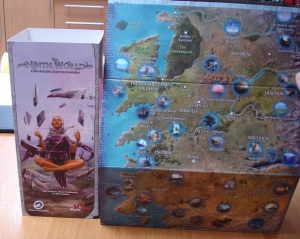 For reasons known only to themselves, the designers opted for a really convoluted box design – it starts off looking more -or-less normal: a box with 2 trays of components stacked on top of each other. However, the score-board is a strange fold-y thing that wraps around the top of the box, and is attached to the box along one edge! Lastly, you have to slide a cardboard sleeve down over the top, to keep the fold-y scoreboard from unravelling, and to make the whole thing feel like a fancy box of alcohol.
For reasons known only to themselves, the designers opted for a really convoluted box design – it starts off looking more -or-less normal: a box with 2 trays of components stacked on top of each other. However, the score-board is a strange fold-y thing that wraps around the top of the box, and is attached to the box along one edge! Lastly, you have to slide a cardboard sleeve down over the top, to keep the fold-y scoreboard from unravelling, and to make the whole thing feel like a fancy box of alcohol.
As far as I can tell, the reason for this box-design was “The creators thought it looked cool.” The practical implications of the fancy box were 1.) The factory messed it up, delaying the game even further, and 2.) the game sits really awkwardly on the table, as the score-board (which you need), has a box (which you don’t need during the game) stuck to it.
The Game
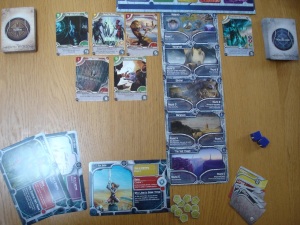 The 9th world is a “skill-building” game. Set 1 Billion years in earth’s future, you control a character who is exploring the world – a place where abandoned advanced technology is basically undistinguishable from magic. This place is known as Numenera, it has its own RPGs, and generally seems like an interesting place.
The 9th world is a “skill-building” game. Set 1 Billion years in earth’s future, you control a character who is exploring the world – a place where abandoned advanced technology is basically undistinguishable from magic. This place is known as Numenera, it has its own RPGs, and generally seems like an interesting place.
There are 5 skills in the game: Scout, Tinker, Charm, Combat and Focus: At the start of the game, you will have level 1 skills in 2 of these, plus 3 generic “effort” cards. You will need to increase the skills you have, and level your ‘efforts’ up into the remaining skills, in order to take down the challenges faced round-by-round.
Each round you will have a certain number of cards dealt from the “town” deck, and others into the “wilderness” Scouting is a pre-requisite of doing any other interacting with Wilderness cards.
There are 3 main types of cards in both the Town and Wilderness decks for The 9th World to chuck at you. 1) Cyphers, which will sit in your play area and provide either ongoing or discard-to-use effects. 2) Creatures, which you simply need to defeat for their victory points, and 3.) Quests, which require you to perform a series of other activities.
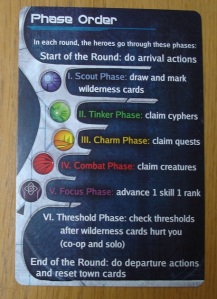 Once you’ve scouted Wilderness cards, you’ll then proceed through 3 fairly similar phases. In the Charm phase you spend Charm points to claim Quests, in the Tinker phase you spend Tinker points to claim Cyphers, and in the Combat phase, you spend Combat points to defeat Creatures – in each case, the number in the top left is what you have to pay, and the number in the bottom-right is your reward for doing so. Many of these cards will have additional effects, modifying the encounter by making life harder or offering an extra reward.
Once you’ve scouted Wilderness cards, you’ll then proceed through 3 fairly similar phases. In the Charm phase you spend Charm points to claim Quests, in the Tinker phase you spend Tinker points to claim Cyphers, and in the Combat phase, you spend Combat points to defeat Creatures – in each case, the number in the top left is what you have to pay, and the number in the bottom-right is your reward for doing so. Many of these cards will have additional effects, modifying the encounter by making life harder or offering an extra reward.
If you use a card in its own phase, then it’s worth the value printed on it. If you use it in any other phase, it’s automatically worth 1. So a Combat 3 card (ideally) counts as 3 points of combat, but in a pinch it can be a single point of Focus, or a point of Charm.
Any bidders?
The 9th World is also a bidding game – each phase, you bid the number of skill points you want to spend that phase. The highest bidder gets to go first, and decide which cards they want to claim with the points they have spent.
Bidding is one of the game mechanics my wife hates the most. I’m not sure if I’d ever get her to play the competitive version of this game. I certainly can’t imagine getting her to play it twice.
 Fortunately, the co-op version of the game (effectively) removes the bidding. You still have to decide what skills to allocate to which phases, but you are allowed to discuss your bids, which just makes it a planning step at the start of the round. Sadly, as already noted, the rulebook isn’t really set-up for people to start with the co-op version, and there are quite a few little things which work slightly differently between co-op and ‘standard,’ which makes for a lot of flicking back-and-forth.
Fortunately, the co-op version of the game (effectively) removes the bidding. You still have to decide what skills to allocate to which phases, but you are allowed to discuss your bids, which just makes it a planning step at the start of the round. Sadly, as already noted, the rulebook isn’t really set-up for people to start with the co-op version, and there are quite a few little things which work slightly differently between co-op and ‘standard,’ which makes for a lot of flicking back-and-forth.
Where 9th World has proved surprisingly frequent in its play, is as a solo game- the solo game is virtually the same as the co-op version and a few solo sessions spent trying to get the rules and mechanics down, quickly turned into a recurring activity – unlike a lot of the games I play solo, The 9th World is quick to set up, quick to play, and quick to set-down after – 40 minutes from leaving to returning to the shelf is comfortably enough time.
Victory?
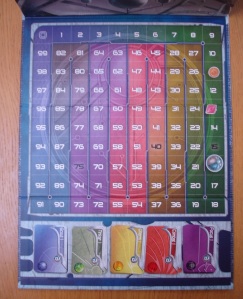 If you play the standard, competitive version of the 9th World, the winner is simply the person with the most Valour (victory points) at the end of pre-set number of rounds (9 for a full game, 5 for a shortened one). In co-op and solo every player has to hit certain point thresholds and if any player falls short, everyone loses. (The thresholds are 15 points by the end of Round 3, 40 by the end of Round 6, and 75 by the end of Round 9).
If you play the standard, competitive version of the 9th World, the winner is simply the person with the most Valour (victory points) at the end of pre-set number of rounds (9 for a full game, 5 for a shortened one). In co-op and solo every player has to hit certain point thresholds and if any player falls short, everyone loses. (The thresholds are 15 points by the end of Round 3, 40 by the end of Round 6, and 75 by the end of Round 9).
The fact that you’re not competing for which cards to spend your skill points on, and shouldn’t ever end up over-bidding, only to find that there’s nothing to do removes a lot of the frustration of the head-to-head version. However, the game does then need a certain amount of balancing to ensure that it remains a challenge.
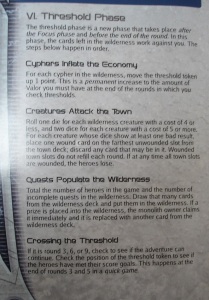 Every round in The 9th World, you re-stock the town to 5 cards, and you add cards to the Wilderness. To begin with, it’s simply 1 card per player, but any quests that you haven’t been able to complete (it’s virtually impossible to complete most quests in a single round) will increase that number by one, meaning that the Wilderness can quickly fill with an unmanageable number of cards.
Every round in The 9th World, you re-stock the town to 5 cards, and you add cards to the Wilderness. To begin with, it’s simply 1 card per player, but any quests that you haven’t been able to complete (it’s virtually impossible to complete most quests in a single round) will increase that number by one, meaning that the Wilderness can quickly fill with an unmanageable number of cards.
Any Cyphers that remain unclaimed in the wilderness increase the points threshold that players need to hit to remain in the game.

Lastly, any creatures which remain in the wilderness will attack the town – roll a dice for small creatures, 2 dice for big creatures, and each dice has a 1 in 3 chance of damaging the town. In the short-term this can reduce the number of town cards available for you to claim (which has rarely been a big deal in any of my games), but much more worryingly, if the town ever takes 5 wounds, you lose the game immediately. This is probably the key element for understanding the “shortened” version of the game – you can afford to take more risks with creatures, and prioritise scoring points quickly.
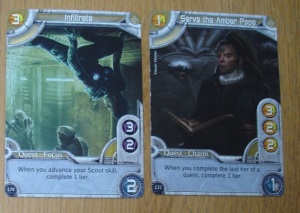
The game certainly isn’t perfect. For one thing, the fancy box that delayed the delivery by a month or more actually hampers playing the game – the place you want to place it for easy access to the score-board generally means that I either end up with a ridiculously cramped playing area, or else the box is constantly on the verge of falling off the table..
Zooming in on the mechanics, the solo game is a fun, puzzle-y co-op, but it can be a bit random: too many quests early on can easily see you swamped, whereas locking things down in the first few rounds can allow you to build up a fairly unassailable position – it’s rare that I lose a game on score, but creature numbers getting out of control and destroying the town is a real threat.
Retail vs Kickstarter
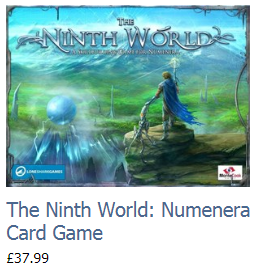
The 9th World did make it to retail, albeit with very little fanfare (I’ve yet to actually see a copy in a bricks-and-mortar store. As such, I’ve been struggling somewhat to establish exactly what the differences between editions are
0.
As far as I can tell, we got extra locations in the KS edition – the locations do alter the game slightly, bringing in different effects in certain rounds, but it’s not a massive element, and I’m not particularly convinced as to how much this added to the gameplay. These cards are notionally a “preview” from a future expansion but, even I believed that the game was popular enough for these expansions to see the light of day, I don’t think I’d bother seeking them out.
There were also 1 or 2 extra town and wilderness cards. Both of these decks are fairly large, so one or two cards shuffled in here has a fairly limited impact (i.e. I’ve already long-since forgotten which ones they were).
As far as I can tell, the characters and skills are all part of the retail edition. It’s nice to vary things up a bit with the character you play, but again, I never felt like we were particularly short on options: there’s a whole set of character powers that you can place over the ability box on their sheet to customise who you play as, and I’ve never even got to the point of using these.
Numbers
I spent just under £60 on this (based on historic exchange rates). The RRP for the retail edition is about £47, and the people who actually have it in stock aren’t really offering much discount on that (the image above with the £38 price-tag has been oos for months). As noted above, I do have more content than the retail-only folks, but I’m not convinced it’s that different.
A game of 9th world rarely takes more than about half an hour. That means I’d need to play it about 25 times to be getting value for money, nearer to 35 to cover the loss vs RRP.
So far I’ve played this seventeen times. Not at all shabby, but still a fair way short of value.
Final Thoughts
I’m not really sure how to feel about the 9th World – I backed it on a bit of a whim, and had almost forgotten about it by the time that it arrived.
Overall, it’s a decent game, and I think my gaming life would be poorer if I’d never played it (not something I’d say about Apocrypha), but £60 poorer? Highly Doubtful.
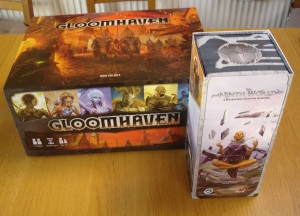 Of the 7 Kickstarters that I’ve backed and received in the past 4 years, 9th World does currently sit somewhere near the bottom, in terms of how much I’ve played it, and how good it appears as value. The overall ranking, in terms of how glad I am that I backed the project tends to mirror this fairly closely, (although The 9th World definitely ranks well above Apocrypha).
Of the 7 Kickstarters that I’ve backed and received in the past 4 years, 9th World does currently sit somewhere near the bottom, in terms of how much I’ve played it, and how good it appears as value. The overall ranking, in terms of how glad I am that I backed the project tends to mirror this fairly closely, (although The 9th World definitely ranks well above Apocrypha).
All that said, there are definitely multiple factors to bear in mind. Of the Kickstarters I’ve backed since 2015, Apocrypha is the only real lemon so far, and 9th World is actually in a fairly small group, going up against some games that we really enjoy – 1 or 2 places behind Gloomhaven is scarcely ‘failure’ by most definitions of the word!
Overall, I’d put The 9th World as a Qualified Success – it’s definitely not a game I would have noticed when it came out at retail, so Kickstarting was more-or-less-necessary to get it. I’m sure I would have survived just fine without it, but it tends to get played most months, and I generally enjoy it when I do.

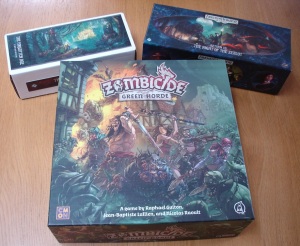 The most popular games of2018 were familiar titles, albeit with a fresh twist:
The most popular games of2018 were familiar titles, albeit with a fresh twist: 
 Despite these big-hitters, 2018 was an even broader year than those which preceded it, with less-and-less time spent on the top few most-played games, relative to everything else.
Despite these big-hitters, 2018 was an even broader year than those which preceded it, with less-and-less time spent on the top few most-played games, relative to everything else.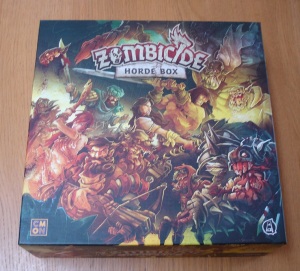
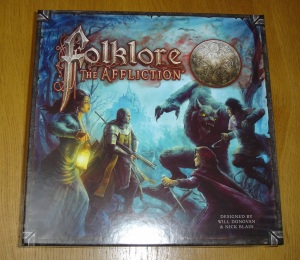 So far, the most questionable Kickstarter for 2018 was
So far, the most questionable Kickstarter for 2018 was 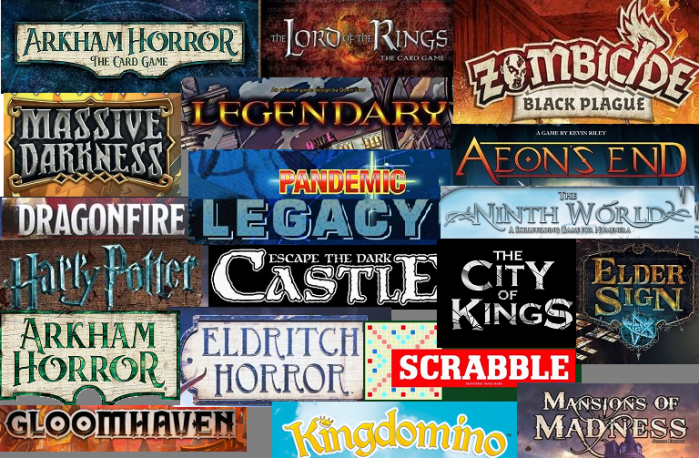
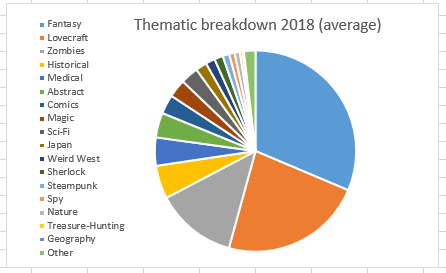 Overall, 2018 presents a fairly familiar pattern – about 1/3 of all gaming was Fantasy Themed, about ¼ was Cthulhu-related, and Zombies were down on about 13%. The only other categories of note were Historical (just over 5%) and Medical (mostly Pandemic) which dominated the first month or so of the year, but faded out as the year wore on.
Overall, 2018 presents a fairly familiar pattern – about 1/3 of all gaming was Fantasy Themed, about ¼ was Cthulhu-related, and Zombies were down on about 13%. The only other categories of note were Historical (just over 5%) and Medical (mostly Pandemic) which dominated the first month or so of the year, but faded out as the year wore on.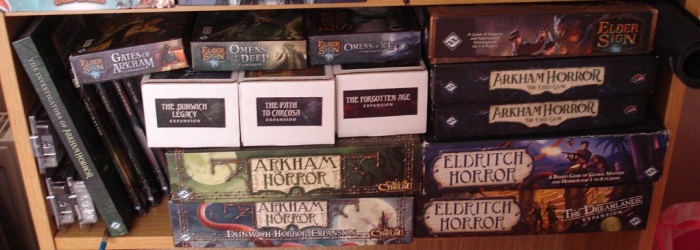 There’s a definite mix here, between games that got a very small add-on (Eldritch had some dice, Massive Darkness a deck of crossover cards), games with only organised-play fees (Dice Masters, L5R), and games where the collection was significantly expanded (the LCGs – LotR and Arkham).
There’s a definite mix here, between games that got a very small add-on (Eldritch had some dice, Massive Darkness a deck of crossover cards), games with only organised-play fees (Dice Masters, L5R), and games where the collection was significantly expanded (the LCGs – LotR and Arkham).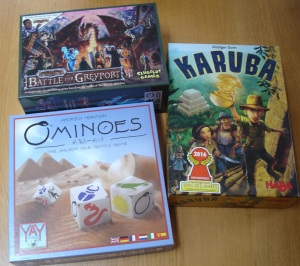 Around
Around 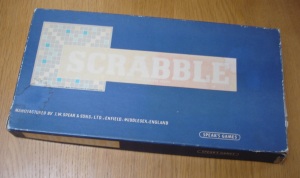
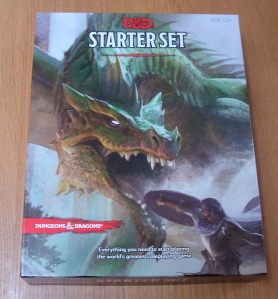 I expect next year to look very different: for one thing, “New Free” will be a long way down, if it still exists at all, and likewise for “Expanded Free,” both due to review work probably no-longer being a thing. On the other hand, I’m hoping to be more involved in an ongoing Dungeons and Dragons campaign at the FLGS, and starting up my own D&D Group (where I’ll will be DM-ing for a few unfortunate souls), so I’m expecting RPGS to be a noticeably larger chunk, by time, if not by session.
I expect next year to look very different: for one thing, “New Free” will be a long way down, if it still exists at all, and likewise for “Expanded Free,” both due to review work probably no-longer being a thing. On the other hand, I’m hoping to be more involved in an ongoing Dungeons and Dragons campaign at the FLGS, and starting up my own D&D Group (where I’ll will be DM-ing for a few unfortunate souls), so I’m expecting RPGS to be a noticeably larger chunk, by time, if not by session.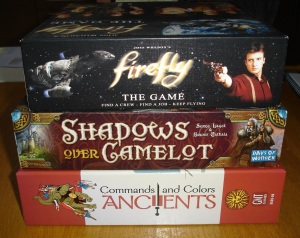 2018 did reach its end with a few games that I own still completely un-played – there was 1 brand-new arrival in Crisis at Steamfall, along with 7 older titles, including 3 repeat offenders.
2018 did reach its end with a few games that I own still completely un-played – there was 1 brand-new arrival in Crisis at Steamfall, along with 7 older titles, including 3 repeat offenders.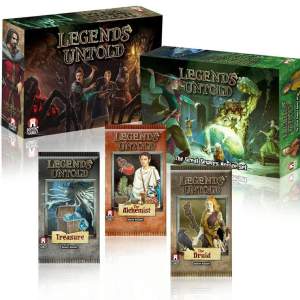
 Beyond that, I don’t really know what else is yet to come – CMON’s
Beyond that, I don’t really know what else is yet to come – CMON’s 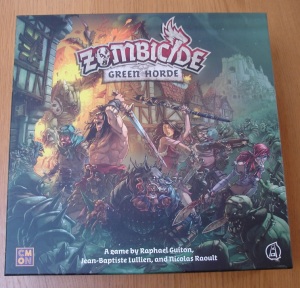 At one extreme, I received the Green Horde core box 7 months earlier than the original estimate.
At one extreme, I received the Green Horde core box 7 months earlier than the original estimate.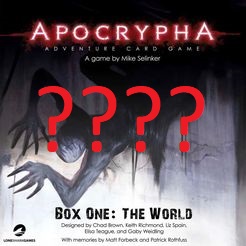 Apocrypha
Apocrypha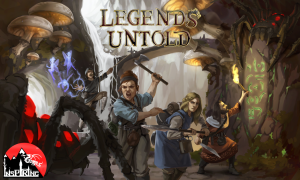 I’m going to start by looking a bit more closely at Legends Untold because, in fairness, I can see some reasonable factors behind a lot of the delays here. As far as I can tell, these were guys who hadn’t worked in the Board Game industry before, and it was
I’m going to start by looking a bit more closely at Legends Untold because, in fairness, I can see some reasonable factors behind a lot of the delays here. As far as I can tell, these were guys who hadn’t worked in the Board Game industry before, and it was 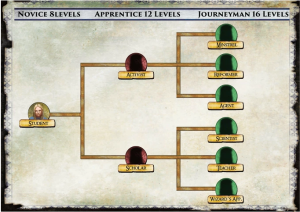 Legends Untold has always billed itself as “Deep as an RPG, Quick as a Card Game” which is quite a claim given how many people have tried (with varying levels of success) to deliver the fabled RPG-in-a-Box over recent years. Theirs was certainly not a narrow vision, and the game they promised us was to have been just the first in a vast network of games, all of which could be woven together into some grand tapestry – Novice Boxes would take you from the beginning up to “Apprentice” level, at which point you would select an “Apprentice Box” to take you up to “Journeyman” level. By the time you had completed one of these, you would not only have reached the great city of this new Fantasy World, but thoroughly explored it, and be ready to go venturing into wilds as a “Skilled” Adventurer.
Legends Untold has always billed itself as “Deep as an RPG, Quick as a Card Game” which is quite a claim given how many people have tried (with varying levels of success) to deliver the fabled RPG-in-a-Box over recent years. Theirs was certainly not a narrow vision, and the game they promised us was to have been just the first in a vast network of games, all of which could be woven together into some grand tapestry – Novice Boxes would take you from the beginning up to “Apprentice” level, at which point you would select an “Apprentice Box” to take you up to “Journeyman” level. By the time you had completed one of these, you would not only have reached the great city of this new Fantasy World, but thoroughly explored it, and be ready to go venturing into wilds as a “Skilled” Adventurer.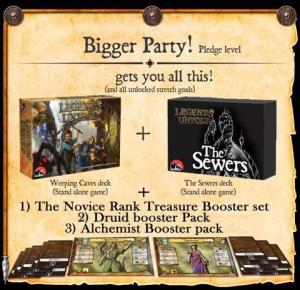 All very grand, but first thing’s first – this campaign was just for the first of the Novice Boxes, The Caves. Or at least it would have been, had they not raised more than 4x their original funding goal within the first 6 days of the campaign. At that point, they decided that the campaign would be for 2 mutually compatible Novice Boxes: The Caves, and The Sewers. Similar in overall structure, this second box would feature different heroes, different enemies, and different environments, but with a reassurance that the content from the various different boxes could be freely mixed-and-matched.
All very grand, but first thing’s first – this campaign was just for the first of the Novice Boxes, The Caves. Or at least it would have been, had they not raised more than 4x their original funding goal within the first 6 days of the campaign. At that point, they decided that the campaign would be for 2 mutually compatible Novice Boxes: The Caves, and The Sewers. Similar in overall structure, this second box would feature different heroes, different enemies, and different environments, but with a reassurance that the content from the various different boxes could be freely mixed-and-matched.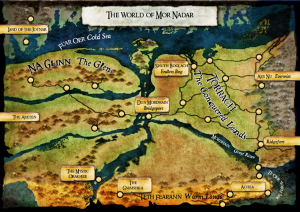
 I have a lot less sympathy for the guys at Lone Shark games. The lead designer of their projects is Mike Selinker, the man behind the Pathfinder Adventure Card Game, Betrayal at the House on the Hill, Lords of Vegas, and the 2004 re-implementation of Axis and Allies. Also involved, aside from a whole host of Pathfinder ACG folk, were Paul Peterson (Smash Up) and Liz Spain (
I have a lot less sympathy for the guys at Lone Shark games. The lead designer of their projects is Mike Selinker, the man behind the Pathfinder Adventure Card Game, Betrayal at the House on the Hill, Lords of Vegas, and the 2004 re-implementation of Axis and Allies. Also involved, aside from a whole host of Pathfinder ACG folk, were Paul Peterson (Smash Up) and Liz Spain (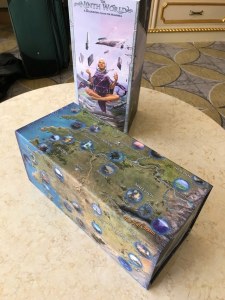 Based on a recent update (
Based on a recent update ( By contrast, going to a small independent, the types of people who Kickstarter feels like it should be for – well, that’s just
By contrast, going to a small independent, the types of people who Kickstarter feels like it should be for – well, that’s just